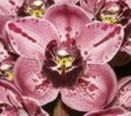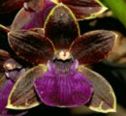


Revised: 10/23/2008
 |
 |
 |
Zygo Culture Revised: 10/23/2008 |
Zygopetalums are the among the easiest of the orchids to grow outdoors in southern California, particularly along the coast and up to 15 or 20 miles inland, and are perfect companions for cymbidiums. Zygopetalums grow best under partial shade-partial sun conditions. Zygopetalums can tolerate considerable summer heat and winter chill without damage. Many growers leave their plants outdoors all year long. Temperatures up to 100 degrees F for short periods such as we encounter in a Santa Ana will not harm the plants although buds may drop on some susceptable plants. Buds and flowers may be damaged if the temperature drops to 29 degrees F but the leaves and bulbs can usually withstand 29 degrees F under shadecloth for a few hours. For temperatures lower than this, some protection will be required.
Adequate light is the most important factor to grow and flower zygopetalums well. The plants grow best with 3000 to 4000 or more foot candles of light intensity as measured with a light meter. 50% lath covering or 55% to 63% shade cloth overhead provides this light intensity under most conditions. Plants grown outdoors will generally be a little more compact and will have tougher leaves than they will when grown indoors. Locations inland may need more shade during the summer to keep the plants from burning. During the summer, the leaves should be a yellowish green, not a deep green. Plants grown in too much shade will usually be a lush green and will often not flower well. Providing additional shade after the flowers open will hold the color and increase the flower life as well. If you provide extra shade for the flowers, remember to remove it when the flowers fall so that the plant will grow best for next year.
Zygopetalums like lots of water and prefer to be constantly moist, but not wet. During the growing season, water thoroughly at least once a week, more often in warmer or drier locations. The amount of water will depend on the potting mix and the water quality. Rain water or demineralized water will give the best results, but water that contains large amounts of dissolved salts such as the Colorado river water we have in Southern California or hard well water can also be used. Open or porous mixes needing more water than a heavy dense mix that retains a lot of water. Water thoroughly so that water runs through the pot and out the bottom. Watering heavily so that excess water flows through the potting mix is a process called leaching which helps to keep the excess salts from Colorado River water or hard well water and fertilizer from building up in the potting mix. Excess salt buildup may cause the leaf tips to die back and the leaves to fall prematurely. Letting the plants dry out and not leaching will cause the leaf tips to die back faster. On hot days, the plants benefit from overhead misting or sprinkling to lower the temperature and increase the humidity in the growing area. During the winter, zygopetalums need less water, but should never be allowed to dry out completely. Watering every 2 or 3 weeks may be adequate, even with no rain.
Zygopetalums are moderate feeders and will do well with the same fertilizer growers use for cymbidiums. Many growers use a high nitrogen fertilizer during the growing season (February to August) and a low nitrogen fertilizer during the blooming season and winter. Others get satisfactory results with a balanced fertilizer all year long. Fertilizer is available in both water soluble and slow release forms. Most growers use a water soluble fertilizer such as Peters 30-10-10 Orchid Special or Miracid during the growing season ar a rate of one teaspoon to a gallon of water and Hi Bloom or similar low nitrogen content water soluble the rest of the year. Many amateur growers use a Hozon or Siphonex to siphon a fertilizer concentrate into a hose to use with a watering wand. Others prefer to use a slow release fertilizer such as Osmocote sprinkled on top of the potting mix. The slow release fertilizers work well where sprinkling systems are used to water the plants. Watering a slow release fertilizer with a watering wand can wash the fertilizer granules off the plant so use care. The slow release fertilizers may be available with 3, 4 or 6 month release times. I would recommend that the amount be cut in half and the application be made twice as often. This compensates for the tapering off often seen with the slow release fertilizers. If possible, it is better to use one of the newer "lite" fertilizer combinations such as the Peters Peatlite formulations that does not contain urea as a nitrogen source. Urea requires a bacterial or chemical reaction in the potting mix to convert it to the nitrate form before the nitrogen is available to the plants, and much is washed out with subsequent waterings before it is converted.
The giant white fly and scale are the two most persistent zygopetalum plant pests with snails and slugs as the principal flower threats. The giant white fly can be controlled with an insecticidal soap. Wipe off as much of the colony as possible, then spray the underside of the leaves well. Scale in the leaf axils can be a persistent problem that is hard to eradicate and the use of a good systemic insecticide may be required. Slugs and snails may be controlled with the available snail and slug baits, or with a big foot and a flashlight at night. Aphids may be attracted to buds and flowers, but are not usually a serious pest. Do not use an insecticidal soap or an insecticide spray with a spreader sticker on zygopetalum buds. We have seen severe deformation of buds and flowers as a result. There is no toxic reaction to the plant itself and such materials may be used when buds are not present. In general, any insecticide should be applied during a cool, shady time of day such as early morning to minimize any potential reaction.
Zygopetalums are relatively resistant to bacterial and fungal diseases. Bacterial and fungal diseases may be a problem under wet and crowded conditions. Adequate spacing of plants on the bench and watering early enough in the day so that the plants can dry out before dark is the best prevention. Zygopetalums can be susceptible to the common orchid viruses. Virus infection of a zygopetalum may be caused by insects feeding on an infected plant and then moving to an uninfected plant, but transmission with contaminated tools during dividing, potting or cutting the flowers is usually the cause. Always sterilize tools and the work area before dividing or repotting each plant, and use disposable rubber gloves or wash hands thoroughly after each plant.
Zygopetalums like a slightly acid potting mix that provides good drainage. Most growers use a fine orchid bark mix with 20% sponge-rok or perlite added. Sand, coarse peat and redwood bark or shavings may be added to improve the water retention in inland locations. Straight seedling orchid bark (1/8 to 1/4 inch) or medium orchid bark can also be used. Zygopetalums are usually not grown with larger grades of bark, but can be with more water.
Zygopetalums generally need to be repotted about every three years under normal conditions. Zygopetalums should be repotted just after the old blooms have fallen off. If the old mix is broken down, the plant should be repotted as soon as possible to minimize root rot. Broken down mix tends to hold too much water and will reduce the air movement around the roots which often causes the older roots to die back. Vigorous plants will often outgrow the pot before the mix starts to break down. When a zygopetalum fills the pot and starts to grow against the edge, it should be repotted even if the mix is not broken down. Potbound zygopetalums may be underwatered which can reduce the vigor and blooming capability.
When dividing and repotting, try to keep divisions with 2 or 3 green bulbs and perhaps one backbulb if you can. Select a pot large enough to allow 3 years growth. For most zygopetalums, a pot which allows 2 inches of room in front of the lead growth is the proper size. Divide plants by breaking apart at the natural divisions. If necessary, use a sterilized knife to separate the bulbs. Clean the old potting mix from the roots and remove any dead or damaged roots. Dead or damaged roots can encourage root rot in the new mix. Place a mound of moist potting mix in the center of the pot. Spread the roots over the mound of mix and work mix in among the roots. Do not ball the roots in the center of the pot. The lower 1/3 of the bulbs should be covered with mix. Tap the pot firmly on the potting bench to help settle the mix around the roots and press the mix firmly around the edge of the pot with a potting stick (I use a hammer handle or a piece of 1/2 or 3/4 inch PVC pipe). The mix should be tight in the pot, not loose. Mix that is too loose in the pot will not provide enough support for the roots and also tends to decompose more rapidly.
All potting tools, knives or shears and potting sticks should be sterilized after each plant to prevent the transmission of disease. Tools may be sterilized by flaming with a propane torch or by soaking in a 50% clorox solution ot a saturated solution of tri-sodium phosphate (TSP) for a few minutes. Don't forget to wash your hands with soap and water also, including under the fingernails. Better yet, use disposable latex or vinyl gloves and discard after each plant. Your hands can transmit disease from one plant to another the same as dirty tools. Plants should be handled or divided on a clean surface. Several layers of newspaper can be spread on the work surface and any that are dirty can be discarded after working with each plant.
After dividing and repotting, the plants should be placed in an area with heavier shade than normal, and should be kept cool and slightly on the dry side for several weeks. This encourages the growth of new roots into the new medium. We water the repotted plants after a day or so in the new mix, and water the first time with a dilute solution of Physan or Naccosan, which is a bactericide and fungicide, to help reduce the likelihood of fungal or bacterial disease in the newly repotted plant. Watering with a dilute solution of Subdue may also help control disease after repotting. Use of an anti transpirant as a spray or drench after dividing and repotting may help reduce the moisture stress on a plant, but we do not find it necessary under our conditions.